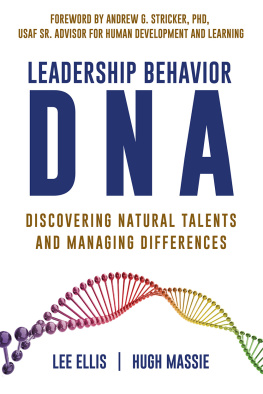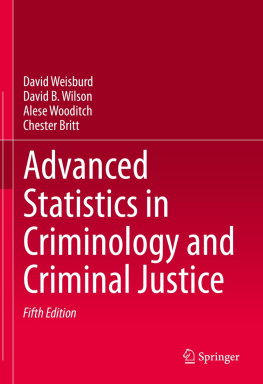
Research Methods in Criminal Justice and Criminology
We teachers know that it is not just students who learn in the classroom. By asking questions, students too can be teachers. This book is dedicated to the many students from whom we have learned so much over the years.
Published by Rowman & Littlefield Publishers, Inc.
A wholly owned subsidiary of The Rowman & Littlefield Publishing Group, Inc.
4501 Forbes Boulevard, Suite 200, Lanham, Maryland 20706
http://www.rowmanlittlefield.com
Estover Road, Plymouth PL6 7PY, United Kingdom
Copyright 2010 by Rowman & Littlefield Publishers, Inc
All rights reserved . No part of this book may be reproduced in any form or by any electronic or mechanical means, including information storage and retrieval systems, without written permission from the publisher, except by a reviewer who may quote passages in a review.
British Library Cataloguing in Publication Information Available
Library of Congress Cataloging-in-Publication Data
Ellis, Lee, 1942
Research methods in criminal justice and criminology : an interdisciplinary approach / Lee Ellis, Richard D. Hartley, and Anthony Walsh.
p. cm.
Includes bibliographical references and index.
ISBN 978-0-7425-6442-8 (cloth : alk. paper) ISBN 978-0-7425-6441-1 (pbk. : alk. paper) ISBN 978-0-7425-6524-1 (electronic)
1. CriminologyResearchMethodology. 2. Criminal justice, Administration ofResearchMethodology. 3. Criminal statistics. I. Hartley, Richard D. II. Walsh, Anthony, 1941 III. Title.
HV6024.5.E43 2010
364.072dc22
2009038559
 The paper used in this publication meets the minimum requirements of American National Standard for Information SciencesPermanence of Paper for Printed Library Materials, ANSI/NISO Z39.48-1992.
The paper used in this publication meets the minimum requirements of American National Standard for Information SciencesPermanence of Paper for Printed Library Materials, ANSI/NISO Z39.48-1992.
Printed in the United States of America
Tables and Figures
Table 1.1:Defining the components of the scientific method.
Table 2.1:Categories of social science variables.
Table 2.2:The four levels at which scientific variables are measured.
Table 2.3:Features of most scientific reports.
Table 3.1:Respect scores for teacher.
Table 3.2:Types of statements scientists rarely and frequently make.
Table 3.3:Comparison of three different approaches to teaching artistic expression.
Table 4.1:Results of a silly hypothetical study.
Table 4.2:A diagram representing the entire range of correlation coefficients.
Table 4.3:Correlation between wealth and male fertility.
Table 4.4:Bivariate and partial correlation coefficients linking religiosity and delinquency.
Table 5.1:Excerpts from research report on the lunar cycle and suicide.
Table 6.1:Average age of death according to handedness.
Table 6.2:Correlation matrix.
Table 6.3:Factor analysis of focal concerns characteristics.
Table 7.1:Conversion of sample size into percentage confidence intervals.
Table 8.1:Return rates in some contemporary mail surveys.
Table 8.2:Average response rates in three different types of surveys.
Table 8.3:Comparisons of self-reported drinking patterns.
Table 8.4:Topics that cause people to feel uneasy in research interviews.
Table 8.5:Differences between responses after the bogus pipeline and after a face-to-face interview.
Table 9.1:Examples of studies based on scenario-type questions.
Table 9.2:Examples of widely used multi-item scales in the social and behavioral sciences.
Table 10.1:Examples of studies based on participant observations.
Table 10.2:Examples of studies based on ethnographic observations.
Table 10.3:Examples of case studies in the social and behavioral sciences.
Table 10.4:Examples of studies based on focus group methodology.
Table 10.5a:Examples of studies based on prehistoric archeological data.
Table 10.5b:Examples of studies based on historic archeological data.
Table 10.6:Analysis programs primarily designed for qualitative data.
Table 10.7:Examples of studies based on laboratory and clinical data.
Table 10.8:Examples of laboratory studies that infer behavior.
Table 10.9:Examples of naturalistic field observational studies.
Table 10.10:Examples of studies based on manipulative field research
Table 10.11:Naturalistic animal observations.
Table 10.12:Examples of research based on content analysis.
Table 10.13:The main types of qualitative direct observational data.
Table 10.14:The main types of quantitative direct observational data.
Table 11.1:Examples of studies based on analyses of contemporary archival data.
Table 11.2:Examples of agencies with massive data sets on the Internet.
Table 11.3:Examples of studies based on analyses of historic archival data.
Table 11.4:Cross-cultural studies based on data available in ethnographic atlases.
Table 11.5:Examples of topics addressed by meta-analyses.
Table 11.6a:Relationships between social status and criminal and antisocial behavior.
Table 11.6b:Relationships between parental social status and criminal and antisocial behavior.
Table 12.1:Estimated number of arrests for crimes by sex and age.
Table 12.2:Items and factor loadings for a self-report measure of psychopathy.
Table 13.1:Examples of animal models developed to understand human behavior.
Table 15.1:Comparisons of quasi-experiments and actual controlled experiments.
Table 17.1:Examples of evaluation research applied to primary prevention programs.
Table 17.2:Examples of evaluation research applied to secondary prevention programs.
Table 17.3:Examples of evaluation research involving treatment programs.
Table 17.4:Examples of evaluation research applied to improvement-oriented programs.
Table App. 1:Mock-up of the first three pages of a typical research report.
Figure 3.1:A frequency distribution curve based on hypothetical data.
Figure 3.2:A bimodal distribution curve based on hypothetical data.
Figure 3.3:Distribution in annual income for U.S. workers, 1982.
Figure 3.4:Duration of marriages that ended in divorce in the United States in 1979.
Figure 3.5:Frequency distribution curve based on hypothetical data.
Figure 3.6:A frequency distribution curve based on hypothetical data.
Figure 3.7a:Two overlapping normal curves not considered different to a statistically significant degree according to a t-test.
Figure 3.7b:Two overlapping normal curves considered different to a statistically significant degree according to a t-test.
Figure 4.1:Scattergram based on five hypothetical observations between shoe size and age.
Figure 4.2:Scattergram based on five hypothetical observations of scores on Variables M and N.
Figure 4.3:Scattergram based on forty-seven hypothetical observations of scores on Variables Y and X.
Figure 4.4:Scattergram of the relationship between Variables Y and X.
Figure 4.5:Scattergram of the relationship between Variables 1 and 2.
Figure 4.6:Scattergram representing the relationship between Variables M and N.
Figure 4.7:Samples of the most common shapes of curvilinear correlational patterns.
Figure 4.8:Scattergram of the relationship between Variables A and B.
Figure 4.9:Relationship between property crime rates and dispersions in income.
Figure 6.1:Mean number of aggressive responses per minute.
Figure 6.2:Trends in homicide rates for various large European cities.
Figure 8.1:Example of a flash card.
Next page







 The paper used in this publication meets the minimum requirements of American National Standard for Information SciencesPermanence of Paper for Printed Library Materials, ANSI/NISO Z39.48-1992.
The paper used in this publication meets the minimum requirements of American National Standard for Information SciencesPermanence of Paper for Printed Library Materials, ANSI/NISO Z39.48-1992.